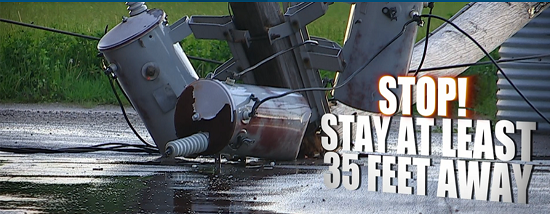The Electrical Safety Foundation International (ESFI) warns consumers to be aware of electrical dangers associated with severe storms and the resulting floods and power outages.
Deaths and injuries during the summer months are frequently caused by post-storm electrical hazards. The high winds, extreme rains, and flooding caused by hurricanes and tornadoes present many unique dangers. ESFI offers consumers important advice about how to help prevent electrically related deaths, injuries, and property loss by taking a few precautions during and after severe storms and other natural disasters.

While we can’t prevent natural disasters, we can ensure our businesses are electrically safe before and after the storm. Practicing electrical safety and being prepared can lead to a smooth recovery and an opportunity to renovate the electrical efficiency of your business.
In the Event of a Natural Disaster
- Create emergency shutdown and start-up procedures
- Turn off power sources
- Charge all electronic communication devices
- Unplug and elevate electronics
After the Storm
- Avoid flooded areas
- Always use a Ground-Fault Circuit Interrupter (GFCI) and transfer switch with portable generators
- Have a qualified electrician inspect any submerged or water-damaged electrical equipment
Prepare for Future Storms
- Micro-grids can prevent long term power outages by providing localized generation and storage
- Smart grids provide smart distribution along with self-healing and autonomous restoration of power
- Having energy sources and major equipment on higher floors may prevent water damage during future storms
Water damaged equipment that must be replaced
- Arc-Fault and Ground-Fault Circuit Interrupters
- Batteries
- Lightning, ballasts, and LED Drivers
- Low and Medium Voltage Fuses
- Molded-Case Circuit Breakers
- Outlet and Junction Boxes
- Receptacles
- Signaling, Protection, and Communications Systems
- Surge Protective Devices
- Switches and Dimmers
- Transformers
- Uninterruptible Power Supply
- Wire or Cable (for dry areas)
Water damaged equipment that may be reconditioned
- High Voltage AC Circuit Breakers
- Low and Medium Voltage Switchgear
- Low-Voltage Power Circuit Breakers
- Motors
- Panelboards
- Switchboards
- Wire or Cable (for wet areas that have not been damaged/ends not exposed)
ESFI has teamed with the National Electrical Manufacturers Association to provide a detailed explanation of what electrical components can be reconditioned and which need to be replaced.
